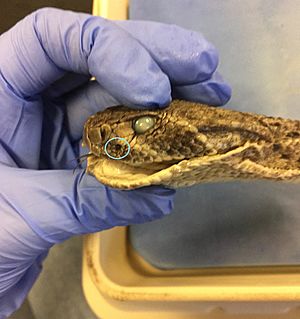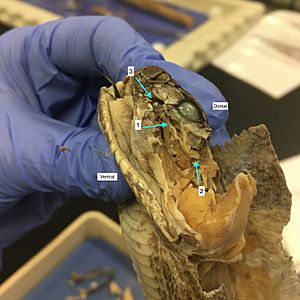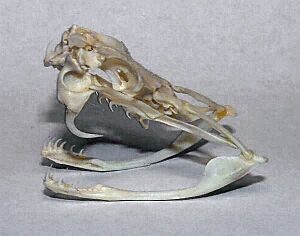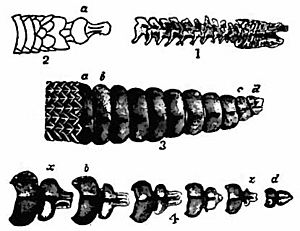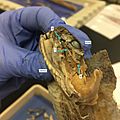Rattlesnake facts for kids
Quick facts for kids Rattlesnake |
|
|---|---|
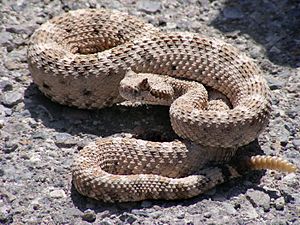 |
|
| Crotalus cerastes | |
| Scientific classification | |
| Kingdom: | |
| Phylum: | |
| Class: | |
| Order: | |
| Suborder: | |
| Family: | |
| Subfamily: | |
| Genera | |
Rattlesnakes are a group of venomous snakes found only in the Americas. They belong to two main groups, called Crotalus and Sistrurus. The name Crotalus comes from a Greek word meaning "castanet", which is a type of musical instrument. Sistrurus is a Latinized Greek word meaning "tail rattler". This name is linked to an ancient Egyptian musical instrument called a sistrum, which is also a type of rattle.
There are about 36 known types of rattlesnakes, with many different subspecies. They live all the way from southern Canada down to central Argentina.
Rattlesnakes are predators. This means they hunt other animals like birds and rodents. They live in many different places, from deserts to forests.
Rattlesnakes get their name from the special rattle at the end of their tails. When they shake their tails, it makes a loud rattling sound. This sound warns other animals or people to stay away. Even with this warning, rattlesnakes can be hunted by animals like hawks, weasels, and kingsnakes. Baby rattlesnakes are especially vulnerable because they are small and weak. Many rattlesnakes are also killed by humans. Because of this, rattlesnake numbers are going down in many areas due to habitat destruction, poaching, and efforts to get rid of them.
Rattlesnakes cause the most snakebite injuries in North America. But they usually only bite if they feel threatened or bothered. If someone is bitten and gets help quickly, the bite is rarely deadly.
Contents
- Where Rattlesnakes Live and Their Homes
- What Rattlesnakes Eat
- How Rattlesnakes Drink Water
- Who Hunts Rattlesnakes
- Rattlesnake Senses
- Rattlesnake Fangs and Venom
- The Rattle
- Rattlesnake Skin and Blood Flow
- Rattlesnake Life Cycle
- Winter Sleep (Brumation)
- Protecting Rattlesnakes
- Safety Around Rattlesnakes
- Antivenin: The Treatment
- Images for kids
Where Rattlesnakes Live and Their Homes
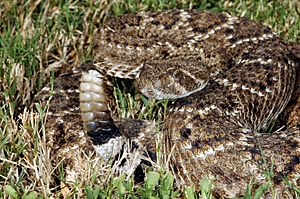
Rattlesnakes are native to the Americas. They live in many different kinds of places, from southwestern Canada to central Argentina. Most types of rattlesnakes live in the American Southwest and Mexico. Only a few types are found east of the Mississippi River or in South America. In the United States, Texas and Arizona have the most kinds of rattlesnakes.
Rattlesnakes can live in almost any habitat that supports land animals that get their body heat from outside sources (called ectothermic vertebrates). However, each type of rattlesnake might need a very specific kind of home. Most prefer rocky areas because rocks offer them places to hide from predators. Rocks also provide lots of prey like rodents and lizards. And they offer sunny spots for the snakes to warm up.
Rattlesnakes can also be found in prairies, marshes, deserts, and forests. They like temperatures between 80 and 90°F (26 and 32°C). But they can survive in very cold temperatures, even below freezing for a short time.
The first rattlesnakes likely came from the Sierra Madre Occidental mountains in Mexico. Their original home was probably pine-oak forests. Rattlesnakes help the environment by controlling the number of rodents. This helps protect crops and keeps ecosystems healthy.
What Rattlesnakes Eat
Rattlesnakes eat mice, rats, small birds, and other small animals. They often wait quietly for their prey to come by. Or they might hunt for prey in holes.
When a rattlesnake bites its prey, the venom quickly kills the animal. They don't squeeze their prey like some other snakes. If the bitten animal moves away before it dies, the rattlesnake can follow its scent. Once the prey has fallen, the rattlesnake checks if it's still alive by nudging it with its snout and flicking its tongue.
After finding the prey's head by smell, the rattlesnake swallows it head-first. This helps wings and limbs fold up so the meal is easier to swallow. Rattlesnakes have very strong stomach fluids that can digest both flesh and bone. They digest best when their body temperature is between 80 and 85 °F (25 and 29 °C). If the meal was small, the rattlesnake might keep hunting. If it was a good meal, the snake will find a warm, safe spot to rest and digest.
How Rattlesnakes Drink Water
Rattlesnakes need to drink at least their own body weight in water each year to stay hydrated. How they drink depends on where the water is. In larger water bodies like streams or ponds, they put their heads under the water. They drink by opening and closing their jaws, which sucks in water. If they are drinking dew or from small puddles, they sip the liquid by flattening their lower jaws.
Who Hunts Rattlesnakes
Many animals hunt newborn rattlesnakes. These include ravens, crows, roadrunners, raccoons, opossums, skunks, coyotes, weasels, whipsnakes, kingsnakes, and racers. Small predatory birds like jays, kingfishers, and shrikes often eat baby rattlesnakes of smaller types. Some ants, like fire ants, also attack young rattlesnakes. Sometimes, hungry adult rattlesnakes even eat baby rattlesnakes.
Only a small number of rattlesnakes (sometimes as few as 20%) live to be two years old. These older snakes are still hunted by larger predators like coyotes, eagles, hawks, owls, falcons, feral pigs, badgers, indigo snakes, and kingsnakes.
The common kingsnake (Lampropeltis getula) is a snake that squeezes its prey. It is not affected by rattlesnake venom, and rattlesnakes are part of its natural diet. Rattlesnakes can smell kingsnakes nearby. When they do, they use a special defense called "body bridging." Instead of coiling up to strike, the rattlesnake keeps its head low to the ground. This tries to stop the kingsnake from grabbing its head, which is usually the first part a kingsnake swallows. The rattlesnake also jerks its body and lifts its back into a coil facing the kingsnake. This raised coil is used to strike the attacker and protect its head.
Rattlesnake Senses
Like all pit vipers, rattlesnakes have two ways to sense their surroundings: their eyes and special heat-sensing "pits" on their faces. These pits help them find prey by sensing the heat their prey gives off. The pits work best within about 1 foot (30 cm). But they give rattlesnakes a big advantage when hunting warm-blooded animals at night.
Heat-Sensing Pits
Besides their eyes, rattlesnakes can detect heat coming from warm-blooded organisms in their environment. Imagine a tiny camera with a pinhole. Heat, in the form of infrared light, goes through the pit's opening and hits a special membrane inside. This warms up that part of the organ. The membrane has many heat-sensitive parts. This allows the rattlesnake to feel tiny temperature changes, even as small as 0.003 °C!
Information from these heat sensors goes to the snake's brain. There, it creates a "heat map" of the surroundings. Because the pit openings are small, these heat images are not very clear. But rattlesnakes combine what they see with their eyes and what they "see" with their heat pits. This helps them understand their surroundings better, especially in low light.
Eyes
Rattlesnake eyes have many special cells that help them see well at night. However, rattlesnakes are not only active at night. Their vision is actually better during the day. They also have cells that allow them to see some colors. Rattlesnake eyes don't have a special spot for sharp vision, so they can't see very clear images. Instead, they mostly rely on sensing movement. Their eyeballs can rotate sideways, but they don't seem to move their eyes to follow things.
Smell
Rattlesnakes have an amazing sense of smell. They can smell things through their nostrils. They also flick their tongues to pick up scent particles. These particles are then carried to special organs in the roof of their mouths called Jacobson's organs, which help them understand the smells.
Hearing
Like all snakes, rattlesnakes don't have outside ear openings. Their inner ear parts are not as developed as in mammals. So, their sense of hearing isn't very strong. But they are very good at feeling vibrations in the ground. These vibrations travel through their skeleton to their auditory nerve, letting them know something is moving nearby.
Rattlesnake Fangs and Venom
Rattlesnake fangs are connected to large venom glands located near the back of their upper jaw. When a rattlesnake bites, muscles around the venom glands squeeze. This pushes the venom through tubes and into the fangs. When the fangs are not being used, they fold back against the roof of the mouth.
Rattlesnakes are born with fangs and venom that work perfectly. They can kill prey right after birth. Adult rattlesnakes shed their fangs every 6 to 10 weeks. They always have at least three pairs of new fangs ready behind the ones they are using.
Venom
Rattlesnake venom is a type of poison that harms tissues, causing damage and problems with blood clotting.
The venom is a mix of many different substances, including enzymes and proteins. These parts help to stop and disable prey. They also contain digestive enzymes that break down tissue, making the prey easier to digest later. The venom is very stable and can stay poisonous for many years.
Older snakes usually have stronger venom. Larger snakes can also store more venom.
The Rattle
The rattle is a warning sign for animals that might try to attack the rattlesnake. It is made of hollow, interlocking segments. These segments are made of keratin, which is the same material as your fingernails. They are formed from special scales at the tip of the tail.
When special "shaker" muscles in the tail contract, these segments rub against each other. Because the segments are hollow, this makes a loud rattling noise. This behavior is called tail vibration. The muscles that shake the rattle are some of the fastest known muscles. They can fire 50 times per second and keep going for up to three hours!
When a rattlesnake is born, it has a small "prebutton" at the end of its tail. This is replaced by a "button" after its first skin shed. The rattle can't make a sound until a second segment is added when the snake sheds its skin again. A new rattle segment is added every time the snake sheds its skin. A snake might shed its skin several times a year, depending on how much food it eats and how fast it grows.
Rattlesnakes hold their rattles up when they move to protect them from damage. But even with this care, the end segments often break off during their daily activities in the wild. Because of this, you can't tell a rattlesnake's age by counting the segments on its rattle.
Male rattlesnakes usually have thicker and longer tails than females. This is because males have certain reproductive organs (called hemipenes) in their tails. Also, male tails gradually get thinner from the body, while female tails narrow suddenly at the vent (the opening where waste leaves the body).
Rattlesnake Skin and Blood Flow
Rattlesnakes, like other snakes, have a circulatory system with a three-chambered heart. This heart has two upper chambers (atria) and one lower chamber (ventricle). The right atrium gets blood without oxygen from the body. The left atrium gets oxygen-rich blood from the lungs and pumps it to the ventricle, which then sends it out to the body through tiny capillaries and larger arteries.
Rattlesnake skin has overlapping scales that cover their whole body. This protects them from drying out and from physical injuries. Most rattlesnakes have small scales on top of their heads, except for a few larger plates right over their snout. Snake skin is very sensitive to touch, tension, and pressure. They can feel pain.
An important job of the skin is to sense changes in air temperature. This helps snakes find warm places to bask or hide. All snakes are ectotherms. This means they get their body heat from their surroundings. To keep a steady body temperature, they exchange heat with the outside. Snakes often move into sunny areas to absorb heat from the sun and warm earth. This is called basking. Nerves in the skin control how much blood flows into the veins near the surface.
Rattlesnake skin has complex patterns that help them camouflage themselves from predators. They usually don't have bright colors. Instead, they have subtle earth tones that blend in with their environment.
The scales of rattlesnakes are connected by folds in their skin. When they swallow large prey, these folds can unfold. This allows their skin to stretch and hold a much bigger meal. The skin looks tightly stretched, but it's actually just smoothing out from its folded state and isn't under a lot of tension.
Rattlesnake Life Cycle
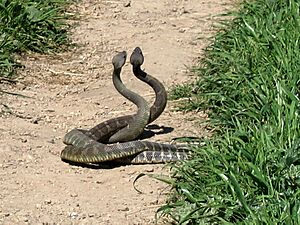
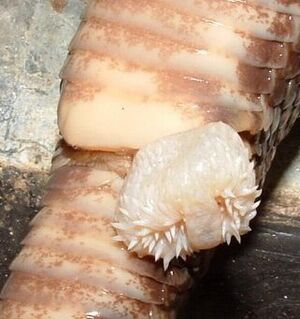
Most rattlesnake species mate during the summer or fall. Some only mate in the spring, or both in spring and fall.
Female rattlesnakes release tiny amounts of special scents called sex pheromones. Males follow these trails using their tongues and Jacobson's organs. Once a male finds a female ready to mate, he often follows her for several days. He will frequently touch and rub her to encourage her.
Males of some species, like timber rattlesnakes, fight each other during mating season to compete for females. These fights are called "combat dances." The two males intertwine the front parts of their bodies, often holding their heads and necks straight up. The larger males usually win and drive the smaller ones away.
Many snakes and other reptiles lay eggs (this is called oviparous). But rattlesnakes are ovoviviparous. This means they carry their eggs inside their bodies and give birth to live young. The female produces eggs in her ovaries. Then, they move through her body into one of her two oviducts. The eggs are arranged in a long chain inside a coiled part of the oviduct.
Some rattlesnakes, like the Arizona black rattlesnake, show complex social behavior, similar to mammals. Females often stay with their young in nests for several weeks. Mothers have even been seen helping each other raise their babies.
Rattlesnakes usually take several years to become adults. Females typically only reproduce once every three years.
Winter Sleep (Brumation)
In the colder winter months, some rattlesnake species go into a period of brumation. This is like hibernation.
They often gather in large groups for brumation, sometimes over 1,000 snakes! They huddle together inside underground "rattlesnake dens" or winter homes. Rattlesnakes often share their winter burrows with many other animals. These can include turtles, small mammals, invertebrates, and other types of snakes.
Rattlesnakes often return to the same den year after year. They might travel several miles to get there. Scientists don't know exactly how they find their way back each year. It might be a mix of scent trails and visual clues like the shape of the land or the sun's position.
Species that have long brumation periods tend to have fewer babies than those with shorter brumation periods or those that don't brumate at all. For example, female timber rattlesnakes in the Appalachian Mountains in New England have babies about every three years. But the lance-headed rattlesnake, which lives in the warm climate of Mexico, has babies every year.
Like most other snakes, rattlesnakes also go into a resting state called aestivation during very hot or dry times. This is why you rarely see them during the hottest and driest summer months.
Protecting Rattlesnakes
Rattlesnakes usually avoid places where humans live. They prefer quiet, natural homes. But fast habitat destruction by humans, large killings during events like "rattlesnake round-ups," and planned efforts to get rid of them are all threatening rattlesnake populations in many areas. Several types of rattlesnakes, like the timber rattlesnake, massasauga, and canebrake rattlesnake, are listed as threatened or endangered in many U.S. states.
Many rattlesnakes also die from being run over by cars.
In areas with more people and traffic, there are more reports of rattlesnakes that don't rattle. People think this might be because humans often kill snakes when they hear them rattle. Snakes that don't rattle are more likely to go unnoticed and survive. Then, they have babies that are also less likely to rattle.
Safety Around Rattlesnakes
Rattlesnakes are the main cause of snakebite injuries in North America. They also cause many bites in Central and South America.
How to Avoid Bites
Rattlesnakes tend to avoid wide-open spaces where they can't hide from predators. They generally try to avoid humans if they know someone is coming. Rattlesnakes rarely bite unless they feel threatened or bothered. Most bite victims are males, often young adults. About half of bites happen when the person saw the snake but didn't try to move away.
It's important to be careful even if you think a snake is dead. A rattlesnake's head can still see, flick its tongue, and bite with venom for up to an hour after it's been cut off from its body.
What Happens if You Get Bitten
About 7,000 to 8,000 people are bitten by venomous snakes in the United States each year. Around five of these bites result in death. The most important thing for survival after a serious bite is how quickly someone gets treatment. Most deaths happen between six and 48 hours after the bite. If treatment with antivenin is given within two hours of the bite, the chance of recovery is very high, over 99%.
When a rattlesnake bites, it can control how much venom it injects. The amount depends on things like the snake's health (does it have long, healthy fangs and a full venom sac?) and its mood (is it an angry, hungry snake that was just stepped on, or a full snake that was just surprised?). About 20% of bites don't involve any venom at all. If there's no burning pain or swelling about 3/8 inch (1 cm) away from the fang marks after one hour, it probably means little or no venom was injected. If there's no swelling or redness around the bite after eight hours, it usually means no venom was injected for most rattlesnake bites.
Common symptoms include swelling, severe pain, tingling, weakness, anxiety, nausea and vomiting, bleeding, sweating, and (rarely) heart problems. The pain after a bite is often very strong and gets worse as the swelling increases. Children usually have more severe symptoms because they receive a larger amount of venom compared to their body size.
Antivenin: The Treatment
Antivenin, also called antivenom, is the common treatment for the effects of pit viper bites. The first step to make antivenin is to collect venom from a live rattlesnake. This is usually done from snakes like the western diamondback, eastern diamondback, South American rattlesnake, or fer-de-lance. The collected venom is then diluted and injected into animals like horses, goats, or sheep. Their immune systems then create antibodies that protect them from the venom's harmful effects.
These antibodies build up in the animal's blood. The blood is then collected and spun very fast (called centrifuged) to separate the red blood cells. The liquid part, called serum, is then purified into a powder. This powder is packaged for use by human patients.
Because antivenin comes from animal antibodies, people sometimes have an allergic reaction during treatment. This is called serum sickness.
Images for kids
-
Stone sculptures of feathered serpents on display at the National Museum of Anthropology in Mexico City
-
Snake handling at the Pentecostal Church of God in the town of Lejunior, Harlan County, Kentucky, September 15, 1946


